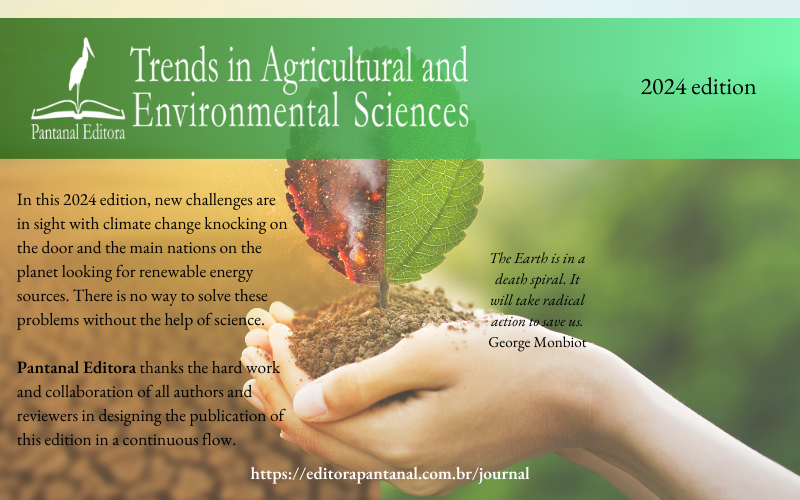Impact of applying the biostimulant Seed+ on initial growth of peanut cultivars
DOI:
https://doi.org/10.46420/TAES.e240001Palavras-chave:
Arachis hypogaea L., seed treatment, sustainabilityResumo
The use of biostimulants in agriculture has been shown to be suitable for stimulating the initial development of several crops; however, reports on its impact on peanut cultivation are scarce. A study was conducted to investigate the effect of application doses of the biostimulant Seed+ on the initial development of two peanut cultivars under controlled greenhouse conditions. The experiment followed a randomized block design in a 2 × 4 factorial scheme: two peanut cultivars [IAC Tatu ST (upright growth habit) and Runner IAC 886 (prostrate growth habit)] and four doses of the biostimulant Seed+ (0, 3, 6 and 9 mL kg–1 of seeds) applied in the seed treatment, with three replications. At 21 days after sowing, plant height (PH), main stem diameter (SD), number of lateral branches (NLB), and main root length (RL) were measured. Our results showed that the use of two improved contrasting cultivars with an erect and prostrate growth habit showed that peanut cultivars have different responses to the doses of biostimulant applied, with crop development, especially for the IAC Tatu ST cultivar. The application of 9 mL kg-1 of the biostimulant Seed+ in seed treatment can be an efficient alternative to stimulate the initial development of peanut cultivars grown in sandy soil of the Cerrado Sul-Mato-Grossense under controlled greenhouse conditions. However, these beneficial effects must be confirmed in experimental trials under field conditions
Referências
Almeida, G. M., & Rodrigues, J. G. L. (2016). Desenvolvimento de plantas através da interferência de auxinas, citocininas, etileno e giberelinas. Applied Research & Agrotechology, 9(3), 111-117. DOI: 10.5935/PAeT.V9.N3.13
Bereta, S. F., Rosa, E. F. F., Kaseker, J. F., Nohatto, M. A., & Luz, S. (2022). Coinoculação de produtos biológicos na cultura do amendoim. Agrarian, 15(55), e15717. DOI: 10.30612/agrarian.v15i55.15717
Bhering, L. L. (2017). Rbio: A Tool For Biometric And Statistical Analysis Using The R Platform. Crop Breeding and Applied Biotechnology, 17, 187-190. DOI: 10.1590/1984-70332017v17n2s29
Binsfeld, J. A., Barbieri, A. P. P., Huth, C., Cabrera, I. C., & Henning, L. M. M. (2014). Uso de bioativador, bioestimulante e complexo de nutrientes em sementes de soja. Pesquisa Agropecuária Tropical, 44(1), 88-94. DOI: 10.1590/S1983-40632014000100010
Oliveira, F. A., Medeiros, J. F., Cunha, R. C., Souza, M. W. L., & Lima, L. A. (2016). Uso de bioestimulante como agente amenizador do estresse salino na cultura do milho pipoca. Revista Ciência Agronômica, 47(2): 307-315. DOI: 10.5935/1806-6690.20160036
Oliveira, F. A., Oliveira, M. K. T., Alves, L. A., Alves, R. C., Régis, L. R. D., & Santos, S. T. (2017). Estresse salino e biorregulador vegetal em feijão caupi. Irriga, 22(2): 314-329. DOI: 10.15809/irriga.2017v22n2p314-329
Souza, F. E. C., Sousa, G. G., Souza, M. V. P., Freire, M. H. C., Luz, L. N., & Silva, F. D. B. (2019). Produtividade de diferentes genótipos de amendoim submetidos a diferentes formas de adubação. Nativa, 7(4), 383-388. DOI: 10.31413/nativa.v7i4.6683
Steiner, F., Zuffo, A. M., Busch, A., Sousa, T. O., & Zoz, T. (2019). Does seed size affect the germination rate and seedling growth of peanut under salinity and water stress? Pesquisa Agropecuária Tropical, 49: e54353. DOI: 10.1590/1983-40632019v4954353
Wylot, E., Ramos, R. F., Mello, A. M., Sobucki, L., Dossin, M. F., & Pavanelo, A. M. (2019). Germinação de sementes de Phaseolus vulgaris L. submetidas a diferentes tratamentos com bioestimulante. Revista Brasileira Multidisciplinar, 22(1), 121-130. DOI: 10.25061/2527-2675/ReBraM/2019.v22i1.623
Downloads
Publicado
Edição
Seção
Licença
Copyright (c) 2024 Trends in Agricultural and Environmental Sciences

Este trabalho está licenciado sob uma licença Creative Commons Attribution-NonCommercial-ShareAlike 4.0 International License.
Attribution-NonCommercial-ShareAlike 4.0 International (CC BY-NC-SA 4.0)
You are free to:
- Share — copy and redistribute the material in any medium or format
- Adapt — remix, transform, and build upon the material
The licensor cannot revoke these freedoms as long as you follow the license terms.
Under the following terms:
- Attribution — You must give appropriate credit, provide a link to the license, and indicate if changes were made. You may do so in any reasonable manner, but not in any way that suggests the licensor endorses you or your use.
- NonCommercial — You may not use the material for commercial purposes.
- ShareAlike — If you remix, transform, or build upon the material, you must distribute your contributions under the same license as the original.
- No additional restrictions — You may not apply legal terms or technological measures that legally restrict others from doing anything the license permits.
Notices:
- You do not have to comply with the license for elements of the material in the public domain or where your use is permitted by an applicable exception or limitation.
- No warranties are given. The license may not give you all of the permissions necessary for your intended use. For example, other rights such as publicity, privacy, or moral rights may limit how you use the material.
This is a human-readable summary of (and not a substitute for) the license.






